 Good Ideas That Can Go Bad
Good Ideas That Can Go Bad
When I first took martial arts -- traditional Kung-fu -- one of the earliest pieces of information I recall is that it is very difficult to try to incapacitate a person by hitting them and trying to "knock them out" without actually endangering their life. The discussion about this got on to things like gas grenades and shooting to wound as well. Even breaking limbs has dangers though there are pressure points that can render a person incapacitated in many situations. Grappling and binding is probably the best option... that is if negotiation and discussion fail of course.
 It made sense to me. But something that seemed a bit irrational was hearing that while most police -- while they had mandatory fire arms re-testing and practised regularly on the firing range -- were not constantly practising and upgrading their hand-to-hand skills. Those are the skills that would allow them to subdue a felon without resorting to baton or gun or...
It made sense to me. But something that seemed a bit irrational was hearing that while most police -- while they had mandatory fire arms re-testing and practised regularly on the firing range -- were not constantly practising and upgrading their hand-to-hand skills. Those are the skills that would allow them to subdue a felon without resorting to baton or gun or...
Well the Taser (image to right -- image from TASER International) had just come onto the scene -- or at least into the public eye -- with first the cattle-prod sort and then with the stun-gun sort which fires wires. It sounded like a great idea -- a way to incapacitate a violent and out of control subject in a way with little danger to the subject or the person trying to subdue them. There were some risks to the target, but less than being pummelled with a billy club or being kicked or punched and definitely less than being shot. (I guess they smile in fire arms catalogues and gun magazines too...)
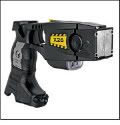 The Tasers were only supposed to be used in special situations. At that time there were groups who said that gradually they would be used in more and more situations until they began to replace negotiation or hand-to-hand subduing of the subject. Because the Taser was "nonlethal force" law enforcement officers would be more likely to use it because no permanent damage would be done. (My own opinion) (image to the left from TASER InternationaLaw Enforcement Overview)
The Tasers were only supposed to be used in special situations. At that time there were groups who said that gradually they would be used in more and more situations until they began to replace negotiation or hand-to-hand subduing of the subject. Because the Taser was "nonlethal force" law enforcement officers would be more likely to use it because no permanent damage would be done. (My own opinion) (image to the left from TASER InternationaLaw Enforcement Overview)
Still there are dangers and there are many circumstances where the targets have health issues that compromise them for being safely Tasered -- or at least I am lead to believe that chronic use of a number of drugs can lead to cardiac issues and a good jolt could be bad or fatal.
I wonder if I were to be hypoglycemic and irrational, whether I might be at risk? It would be one condition under which I might find myself facing law enforcement officers while not in my right mind. My own heart is strong, but many diabetics have heart conditions.
 I can see that there are many areas that the Tasers are very usefully important. (image to the right US military version, the M-26 Taser - from Wikipedia) But I think that there needs to be constant diligence in training with them -- not just firing range sorts of point and shoot or "here is what it feels like to get hit". I think that there needs to be constant training and upgrading which includes hand-to-hand, Taser, and firearms along side negotiation. Also other new weapons that might come down the line.
I can see that there are many areas that the Tasers are very usefully important. (image to the right US military version, the M-26 Taser - from Wikipedia) But I think that there needs to be constant diligence in training with them -- not just firing range sorts of point and shoot or "here is what it feels like to get hit". I think that there needs to be constant training and upgrading which includes hand-to-hand, Taser, and firearms along side negotiation. Also other new weapons that might come down the line.
I can well imagine the military having valid use for these sorts of "nonlethal" weapons.
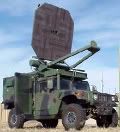 There are other "nonlethal" weapons coming down the pipe. The Tera Hertz frequency Active Denial weapons are one of them which can create a burning sensation that leaves little or no mark on the target, but few if any can stand for more than a few seconds. Vehicle mounted ones are in operation (image to left - image from Wikipedia) and more portable ones are coming as new technology allows. (image to right - image from Wikipedia)
There are other "nonlethal" weapons coming down the pipe. The Tera Hertz frequency Active Denial weapons are one of them which can create a burning sensation that leaves little or no mark on the target, but few if any can stand for more than a few seconds. Vehicle mounted ones are in operation (image to left - image from Wikipedia) and more portable ones are coming as new technology allows. (image to right - image from Wikipedia) 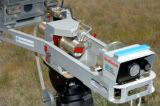 This might be a very important tool -- but what happens if it might be used for something other than the "crowd control" and keeping terrorists away from sensitive areas? There is potential for using it as a torture device. This is not something I came up with but rather something that the same people who worried about abuse with the Taser came up with.
This might be a very important tool -- but what happens if it might be used for something other than the "crowd control" and keeping terrorists away from sensitive areas? There is potential for using it as a torture device. This is not something I came up with but rather something that the same people who worried about abuse with the Taser came up with.
The safety of the ADS (Active Denial System) has been stated with regards to people not being able to stay within the active beam of the device for longer than a second or two. It only penetrates to 0.4 mm (1/64 of an inch) -- a depth at which nerve endings are located. This is because of the 95 GHz frequency chosen which is absorbed greatly by water and hence can't penetrate deeper. Little mention is of the effect on a subject who cannot flee the effect of the ADS or the effect of the 95 GHz radiation on the cornea or other thin tissues of the body.
I am sure in the case where the ADS is used as it is intended the argument can be made that the person should not be there and the ADS is less dangerous than other means. But, what if it starts to be used in broader ranges and scopes of purpose? What about dispersing crowds at sporting events? What if people do not disperse quite as quickly as Law Enforcement prefer from the scene of an accident or fire? Someone who is a bit of a radical mentions the scenario of police using them for raids where the ADS is used to chase the targets out of a residence to take them into custody. This would use other Tera Hertz tools to locate the targets in the building as well.
What of privacy...
 There are THz scanners that essentially can see through anything other than flesh and metal. So that you would stand before them only covered by the zipper on your trousers and change in your pockets... and keys, jewellery, buckles.... but you would be bald er than the day you were born in the image and though in black and white, not looking like an X-ray photo. (image to left - image from BBC News) Now such scanning is optional to avoid longer hand pat downs... also invasive. (image to right - image from BBC News)
There are THz scanners that essentially can see through anything other than flesh and metal. So that you would stand before them only covered by the zipper on your trousers and change in your pockets... and keys, jewellery, buckles.... but you would be bald er than the day you were born in the image and though in black and white, not looking like an X-ray photo. (image to left - image from BBC News) Now such scanning is optional to avoid longer hand pat downs... also invasive. (image to right - image from BBC News) 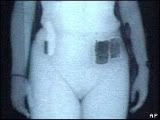 But perhaps they might be required in more and more places and if you don't submit... well if you are law abiding, what do you have to hide?
But perhaps they might be required in more and more places and if you don't submit... well if you are law abiding, what do you have to hide?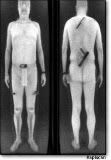 (image to left - image from Italy Magazine Forums)
(image to left - image from Italy Magazine Forums)
I believe the two images are actually using X-ray back scatter technique and do not show quite as graphic detail as the actual T-ray units would show. I also believe that there has been a bit of airbrushing to reduce embarrassment. Somehow I wonder if there are reasons why it is harder to find images of the actual images from the T-ray units? I can only speculate.
Another technology is that of the tracking chip. People might know about the RFD tracking chips that have been implanted beneath the skin of pets for a number of years. They are also used for keeping track of wild animals like crocodiles in Florida or sharks or other animals. You catch an animal or get close to it and swipe a wand over it and record the number of its implanted chip via radio signal generated when the wand passes by and you can then look up information on that animal and record information such as where you swiped it.
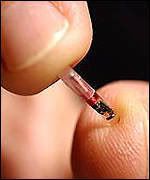 The same would happen for people. It could be used as a form of ID. Your ID information would be encoded on the chip -- or at least a code number that could be accessed from a database on a network -- and read with an appropriate device. I believe there have been some trials with people using such implanted chips for Charge Cards and for security in their home and office.
The same would happen for people. It could be used as a form of ID. Your ID information would be encoded on the chip -- or at least a code number that could be accessed from a database on a network -- and read with an appropriate device. I believe there have been some trials with people using such implanted chips for Charge Cards and for security in their home and office.
RFD tracking chip from VeriChip. (image to right - image from BBC News)
It is an interesting idea, but... it might be used in more and more situations until people will nearly insist that you use it to use certain facilities. Consider how hard it can be to function without a credit card or a bank debit card. Consider that readers could be easily mounted at entrances to all banks, subway station entrances, airports, or anyplace sensitive. You could be tracked as easily as they can track where you make credit card purchases or cell phone calls... easier in fact.
What if someone has a scanner and gets your code? Can't they code a chip and simply have it on their person and then be treated as if they were you?
If you won't get a chip implanted... why not? Do you have something to hide?
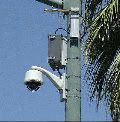 I guess the same goes for surveillance cameras. How they are used and who gets access to them makes a big difference. How the regulation on who gets to change the rules on who gets to access them is just as important. I can understand the concept that the cameras are placed to look at places where you might be seen by a casual passerby. So what you do could be seen by a police officer who is not in uniform as well as that security camera. But it could get a bit creepy if access might be granted to folk you might not think should gain access.
I guess the same goes for surveillance cameras. How they are used and who gets access to them makes a big difference. How the regulation on who gets to change the rules on who gets to access them is just as important. I can understand the concept that the cameras are placed to look at places where you might be seen by a casual passerby. So what you do could be seen by a police officer who is not in uniform as well as that security camera. But it could get a bit creepy if access might be granted to folk you might not think should gain access.
I am not sure I would want a chip implanted... I don't mind the downtown video surveillance cameras or the ones in public places like malls and universities.... Tasers are okay if they actually start training the officers with them... I think there need to be some sort of safe guards before things like the ADS are used outside of war zones. I know of a few other "nonlethal" systems as well...
...what about the stuff we don't know about? Sometimes you have to worry about who they are using for watchdogs on the new technologies or what directions current technologies are taking.
Personally I am not against all of this technology, I am just pointing out the potential of sliding down some very slippery slopes with it.
Later!
~ Darrell
116.


 Stumble It!
Stumble It!

No comments:
Post a Comment